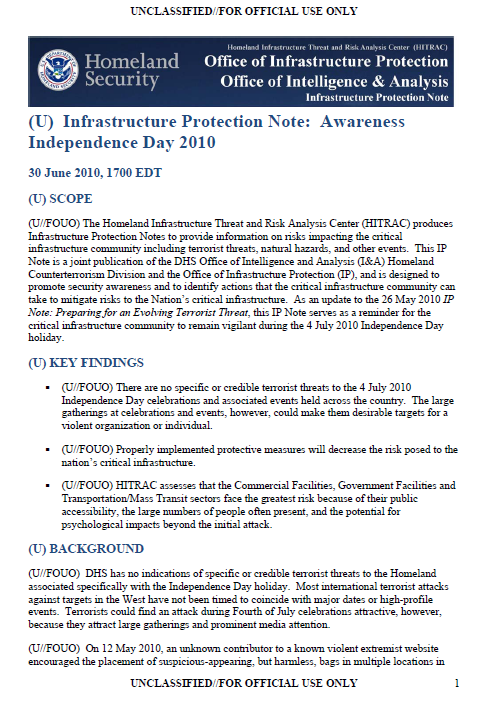 Homeland Infrastructure Threat and Risk Analysis Center
Homeland Infrastructure Threat and Risk Analysis Center
- 3 pages
- For Official Use Only
- June 30, 2010
(U//FOUO) The Homeland Infrastructure Threat and Risk Analysis Center (HITRAC) produces Infrastructure Protection Notes to provide information on risks impacting the critical infrastructure community including terrorist threats, natural hazards, and other events. This IP Note is a joint publication of the DHS Office of Intelligence and Analysis (I&A) Homeland Counterterrorism Division and the Office of Infrastructure Protection (IP), and is designed to
promote security awareness and to identify actions that the critical infrastructure community can take to mitigate risks to the Nation’s critical infrastructure. As an update to the 26 May 2010 IP Note: Preparing for an Evolving Terrorist Threat, this IP Note serves as a reminder for the critical infrastructure community to remain vigilant during the 4 July 2010 Independence Day holiday.(U) KEY FINDINGS
- (U//FOUO) There are no specific or credible terrorist threats to the 4 July 2010 Independence Day celebrations and associated events held across the country. The large gatherings at celebrations and events, however, could make them desirable targets for a violent organization or individual.
- (U//FOUO) Properly implemented protective measures will decrease the risk posed to the nation’s critical infrastructure.
- (U//FOUO) HITRAC assesses that the Commercial Facilities, Government Facilities and Transportation/Mass Transit sectors face the greatest risk because of their public accessibility, the large numbers of people often present, and the potential for psychological impacts beyond the initial attack.
…
(U) PROTECTIVE MEASURES
(U//FOUO) DHS has identified measures suited for protecting these critical infrastructure against
suicide attacks, IEDs, and vehicle borne improvised explosive devices.2,3(U//FOUO) State, local, tribal, territorial, and private sector partners play a critical role in
identifying suspicious activities and raising awareness of federal counterterrorism officials. The
“If You See Something, Say Something,”4 campaign developed by New York City’sMetropolitan Transportation Authority (MTA) is a best practice that can be readily adopted
nationwide. It effectively stresses that every individual can be a part of the first line of defense
against a terrorist attack. The attempted 1 May Times Square bombing showcased the value of
raising public awareness and the importance of remaining vigilant.(U//FOUO) By following the recommended procedures, facility owners can mitigate some of the
risks associated with an attack.(U//FOUO) The principal objectives of protective measures are to complicate attack planning
and surveillance, protect potential targets, and mitigate the risk of an attack. An effective
approach should involve three phases: prevention, assessment and detection, and response.(U//FOUO) Prevention Phase: This phase incorporates security procedures that complicate
attack planning and execution, increase the safety of the public and response personnel in threat
situations, and promote consistent reporting of suspicious activities. Best practices include:
- (U//FOUO) Establishing a public awareness and vigilance campaign that reinforces public awareness of threats, and ensuring that a simple and consistent mechanism is in place to report suspicious activities.
- (U//FOUO) Maintaining police presence at strategic locations within at-risk venues, specifically at all entrance sites or traffic choke points.
- (U//FOUO) Identifying and pre-designating primary and secondary evacuation routes and assembly areas for building or site occupants.
(U//FOUO) Assessment and Detection Phase: This phase addresses considerations of vehicle
assessment to rule out potential threats or determine the need to request bomb squad response.
- (U//FOUO) Conduct random explosive detection canine searches to avoid taxing valuable resources.
- (U//FOUO) Stagger search times and patterns to implement counter-surveillance measures.
- (U//FOUO) Canvas area to garner information and/or witness information to determine “who, what, when, where, and why” for an unattended vehicle left at site, in order to rule out legitimate deliveries, etc.
(U//FOUO) Response Phase: This phase addresses protective actions necessary once a threat or
attack is recognized.
- (U//FOUO) Evacuate the threatened or attacked area, ensuring that the evacuation site is far enough away to protect individuals from blast and fragmentation; suspicious vehicles should not be moved until cleared by bomb squad personnel.
- (U//FOUO) Maintain awareness of the possibility of a secondary device that targets an evacuation site, or a command post used by emergency responders.
